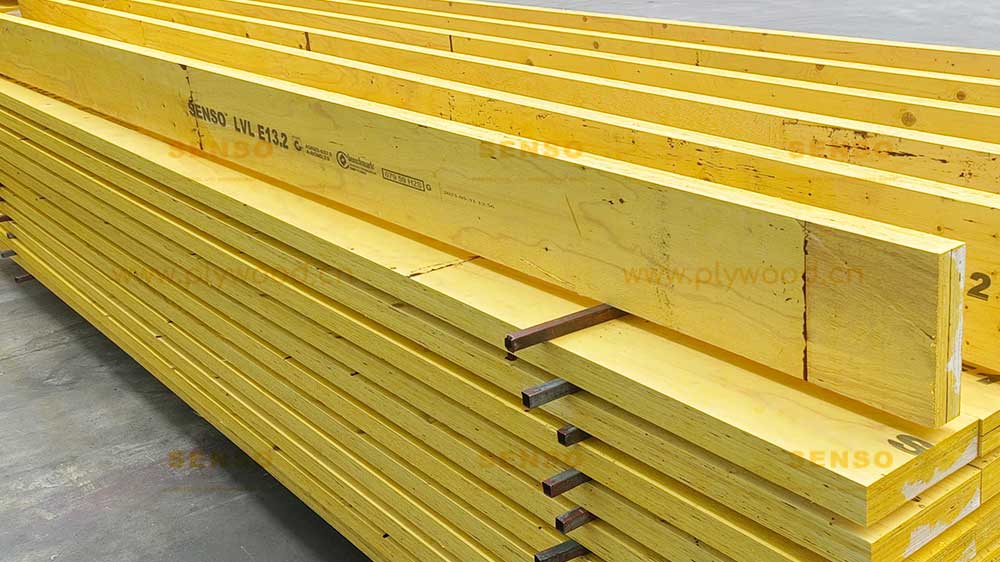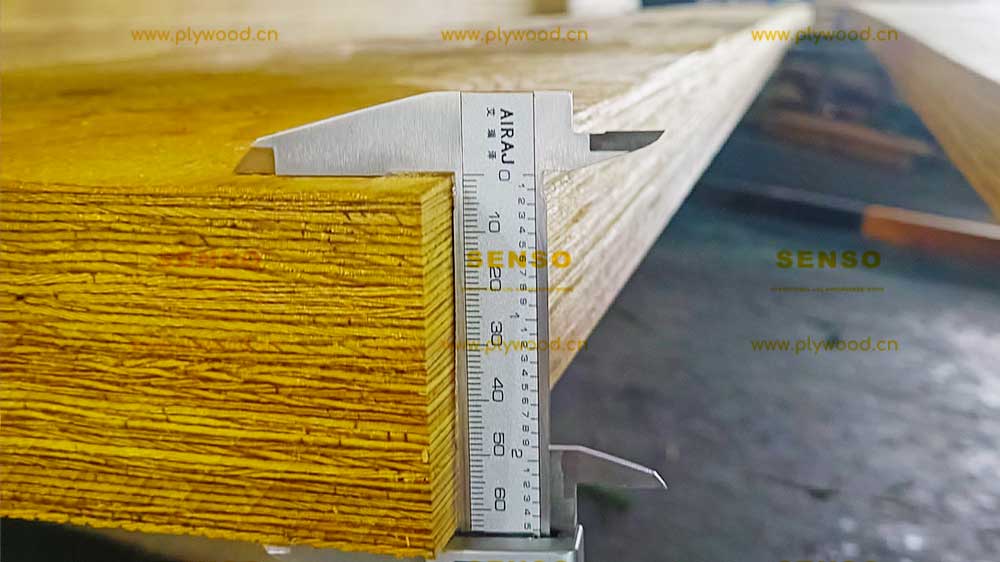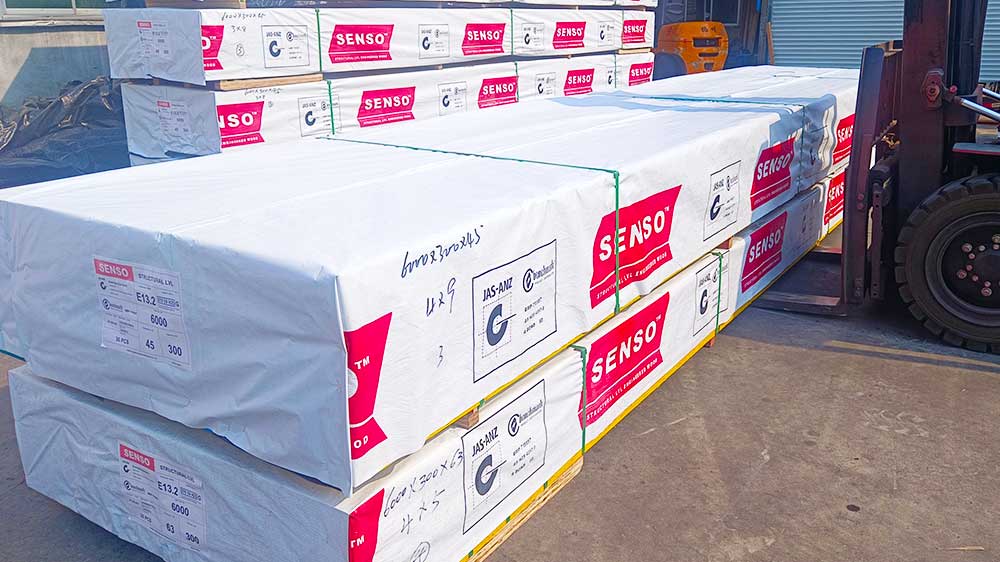What is LVL Lumber?
Laminated Veneer Lumber (LVL) is an engineered wood product that combines multiple layers of thin wood assembled with adhesives. Unlike traditional lumber, LVL beams provide enhanced strength, stiffness, and dimensional stability. This makes them an ideal choice for structural applications in residential and commercial construction. The process of creating LVL lumber ensures uniformity and consistency. It is free from natural defects like knots and warping. As a result, LVL beams can support heavier loads. They are suitable for longer spans than solid wood. This makes them preferred by architects and builders. They aim for aesthetic and functional excellence in projects.
The Advantages of Using LVL Beams
Enhanced Strength and Durability
LVL lumber is known for its exceptional strength and durability. Its engineered composition allows it to withstand heavy loads and resist bending or warping, ensuring long-lasting structural integrity. This makes LVL beams particularly suitable for areas of construction that demand high performance, such as load-bearing walls, floors, and roofing systems.
Versatility in Design
The versatility of LVL beams lies in their ability to be customized to meet specific project requirements. They can be produced in various lengths and depths, offering flexibility in design and application. This adaptability extends to both residential and commercial construction, where LVL lumber can be used in a variety of structural and non-structural applications.
Environmental Sustainability
LVL beams are a more environmentally friendly option compared to traditional lumber. The manufacturing process of LVL lumber maximizes the use of wood resources by utilizing smaller trees and minimizing waste. Additionally, the adhesives used in the production of LVL beams are typically formaldehyde-free or low-emitting, contributing to healthier indoor air quality.
Cost-Effectiveness
The initial cost of LVL lumber may be higher than traditional wood. However, its superior strength and durability can lead to long-term savings. LVL beams can span longer distances. They don’t need as many intermediate supports. This can reduce material and labor costs. LVL lumber’s dimensional stability minimizes future repairs. It also reduces the need for replacements due to warping. This enhances its cost-effectiveness.
Installation Efficiency
LVL beams are lighter than solid wood beams of comparable strength, making them easier to handle and install. This can significantly reduce construction time and labor costs. Additionally, the precision of LVL lumber dimensions allows for a more straightforward installation process, as there is less need for onsite modifications.
Applications of LVL Lumber in Construction
LVL lumber is increasingly being utilized in a wide range of construction applications due to its superior properties. Some common uses include:
- Floor Joists and Beams: LVL beams are ideal for floor systems, providing the necessary support and stability for both residential and commercial buildings.
- Roof Rafters and Trusses: The strength and dimensional stability of LVL lumber make it suitable for roof structures, enabling architects and builders to design spacious and open interiors without compromising on safety or aesthetics.
- Wall Framing: LVL beams can be used in load-bearing walls and as lintels over doors and windows, offering enhanced structural support.
- Bridges and Scaffolding: The high strength-to-weight ratio of LVL lumber makes it a preferred material for temporary structures like bridges and scaffolding, where durability and safety are paramount.
Innovation in Construction with LVL Lumber
Customization and Precision
One significant advantage of LVL beams is their customizable nature. They cater to complex architectural designs’ precise requirements. This customization includes on-site cutting and drilling. Last-minute adjustments are possible. These adjustments don’t compromise the material’s structural integrity. Such precision is invaluable in projects that require intricate detailing or unique structural solutions.
Enhanced Safety Features
Safety is paramount in construction, and LVL lumber contributes significantly to building safer structures. Its manufacturing process ensures a consistent quality and strength throughout the beam, reducing the risk of failure under load. Moreover, LVL beams are treated with fire-retardant chemicals, enhancing their resistance to fire and making them a safer choice for residential and commercial buildings.
Impact on Architectural Design
The strength and versatility of LVL beams have a profound impact on architectural design, enabling more ambitious and innovative projects. Architects can now design larger, open spaces without the need for obstructive support columns, creating more aesthetically pleasing and functional interiors. The use of LVL lumber also facilitates the construction of complex, curved structures, pushing the boundaries of conventional design.
Sustainability and Environmental Impact
The conversation around construction materials increasingly focuses on sustainability, and LVL lumber is at the forefront of this shift. The production of LVL beams uses younger, fast-growing trees, which are a more sustainable resource than the old-growth timber required for traditional wood beams. Additionally, the efficient use of wood in the laminating process reduces waste, further lessening the environmental footprint of construction projects.
Certification and Standards
LVL lumber is subject to rigorous testing and certification processes to ensure its performance and quality. Certifications such as the Sustainable Forestry Initiative (SFI) or Programme for the Endorsement of Forest Certification (PEFC) attest to the sustainable sourcing of wood used in LVL production. These standards provide assurance to builders and clients of the material’s environmental credentials and its contribution to sustainable construction practices.
Economic Considerations
Long-Term Value
The upfront cost of LVL lumber may be higher than traditional materials. However, its durability, strength, and ease of installation offer long-term savings. The reduced need for maintenance is a benefit. Structures built with LVL beams have longevity. This translates into significant economic advantages. These advantages are evident over a building’s lifespan.
Market Trends and Availability
LVL beams are adopted in construction projects worldwide. This adoption is a testament to their potential. They can revolutionize the industry. Looking to the future, LVL lumber’s role is undeniable. It fosters sustainable, efficient, and innovative practices. Advancements in engineering and material science are ongoing. LVL beams will continue to evolve. They will offer even greater possibilities. These possibilities extend to architectural design and construction.
The Future of Construction with LVL Lumber
The demand for LVL lumber is rising. Its superior properties drive this demand. The construction industry is shifting towards sustainable practices. This shift increases demand. Production and availability have increased. LVL beams are now viable for many projects. The market for LVL beam is expanding. We can expect further innovations. Efficiencies will also increase. This will make LVL lumbers even more attractive to the construction industry.
Advancing Technologies in LVL Lumber
Technological Enhancements
The future of LVL lumber looks promising, with continuous advancements in manufacturing technologies enhancing its properties and applications. Innovations in adhesive technologies, for instance, are improving the moisture resistance and overall durability of LVL beams. Furthermore, developments in digital fabrication techniques, such as CNC machining, allow for even greater precision in the customization of LVL beams, expanding its utility in complex architectural projects.
Integration with Smart Building Practices
As the construction industry moves towards smarter building solutions, laminated veneer lumber is poised to play a key role. Its compatibility with sensor technology, for instance, enables real-time monitoring of structural integrity, moisture levels, and other critical parameters. This integration not only ensures the longevity and safety of structures but also aligns with the industry’s drive towards predictive maintenance and sustainability.
Global Trends in LVL Lumber Usage
The global construction landscape is increasingly recognizing the benefits of laminated beams, with its usage expanding beyond traditional markets. Countries with strong commitments to sustainable building practices are leading the adoption of LVL beams, integrating them into public infrastructure, residential projects, and commercial buildings. This global trend underscores the material’s versatility and its alignment with environmental goals.
Addressing FAQs About LVL Lumber
Is LVL Stronger Than Regular Lumber?
Yes, LVL is significantly stronger than regular lumber. Its engineered structure, created by bonding multiple layers of wood veneers with strong adhesives, provides superior strength, stiffness, and resistance to warping or twisting.
What is the Difference Between PSL and LVL Lumber?
Parallel Strand Lumber (PSL) and Laminated Veneer Lumber (LVL) are both types of engineered wood products but differ in their composition. PSL is made from long, thin strands of wood glued together, while LVL consists of thin wood veneers laminated together. Each has unique properties and uses, with LVL being more widely used for beams and headers due to its consistent strength across large spans.
What is LVL Lumber Used For?
LVL lumber is used in a variety of structural applications, including beams, rafters, floor joists, trusses, and columns. Its strength and stability make it ideal for areas requiring long spans without support, such as open-plan spaces.
Is LVL Stronger Than Plywood?
Yes, LVL is stronger than plywood. While both are made from layers of wood, the manufacturing process of LVL aligns the grain of all veneers in the same direction, enhancing its strength and load-bearing capacity.
Is LVL Cheaper Than Wood?
The initial cost of LVL may be higher than that of traditional wood, but its superior strength, durability, and the potential for longer spans can result in overall cost savings in construction projects by reducing the need for additional supports and maintenance.
Paving the Way for Sustainable Construction
The shift towards LVL lumber in construction is not just a trend but a reflection of the industry’s commitment to sustainability, efficiency, and innovation. As we move forward, the role of LVL beams in enabling more resilient, eco-friendly, and adaptable structures will undoubtedly grow. The continuous improvement in manufacturing processes and the integration of advanced technologies will further solidify LVL lumber’s position as a cornerstone of modern construction.
Summarizing the Transformative Impact of LVL Lumber
LVL lumber’s journey from an innovative material to a cornerstone of contemporary construction underscores its unmatched strength, versatility, and sustainability. The construction industry is evolving. LVL beams are at the forefront of this change. They offer structurally superior solutions. They are also environmentally responsible. Advancements continue in LVL lumber. Its global footprint is growing. It is setting new standards in building. A new era in construction is marked. This era values efficiency, sustainability, and innovation.
Post time: Apr-01-2024




